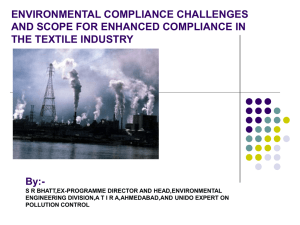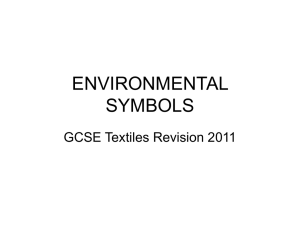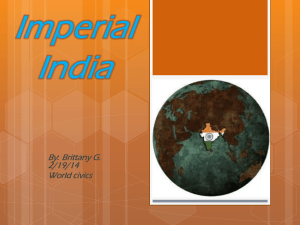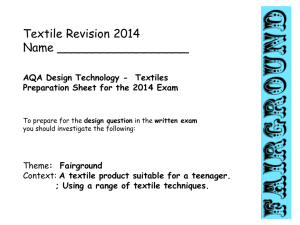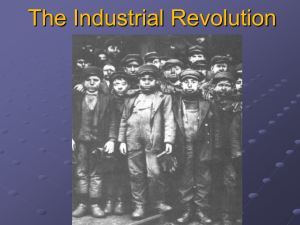Document
advertisement
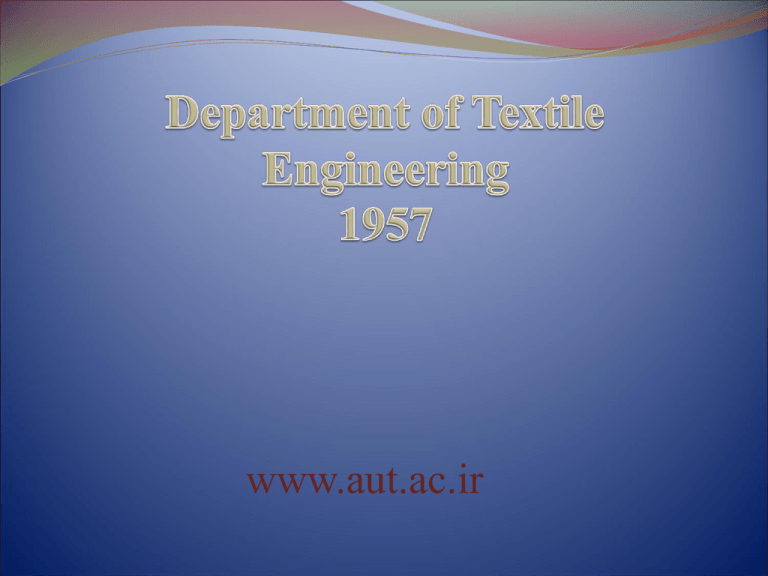
www.aut.ac.ir Dr. Hooshang Nosraty ( Associate Professor ) Head of Textile Engineering Department History Founded in 1957 More than 2638 graduates since 1961 Department of Textile Engineering The Department of Textile Engineering began its teaching and research activities in 1957 as the first of its kind in the country. It is one of the oldest departments of Amirkabir University of Technology and is active in the fields of Textile Chemistry, Fibre Science, Textile Technology, Clothing and Textile Management at BSc, MSc and PhD levels. The department is housed in an eleven-storey building covering an area of 27,000 square meters. Department of Textile Engineering Currently has 5 Academic Groups. Textile Chemistry Fibre Science Textile Technology Clothing Textile Management Nano-fibrous structures Activities: One of the teaching aims of DTE is to improve the technological skills of workers and professionals in the textile industry. Consequently, various courses are held by the department to achieve this aim. So far four long-term courses have been held for the Textile Industrial Committee of Iran and two are currently being held as well as a number of short-term courses according to the needs of the industrial centers and factories. The research activities of DTE include: Projects related to the dissertations and theses of students at all levels Projects for industry Independent research projects Projects carried out in the man-made fibre research center Virtual Education: Textile Industries Management Engineering Distribution of Students percent Male percent Female Total of Students Total of University 42 86 58 121 207 Graduate 55 235 45 195 430 B.S. 37 56 63 95 151 M.S. 54 30 46 26 56 Ph D Graduate & Under Graduate Graduate % Student 33 207 B.S. % 67 Student 430 AUT Graduates Total Male Female Degree B.S. M.S. PhD Total Academic Members Professors : 6 Associate : 12 Assistant : 8 Lecturers : 4 Total : 30 Graduate Courses Textile (Ph.D. Program) PHYSIC AND MECHANIC OF FABRIC MECHANICAL& RHEOLOGICAL PROPERTIES OF FIBRES NECESSARY COURSES REGARDING TO STUDENTS RESEARCH FIELD ( 6 COURSES EQUALS 18 UNITS ) QUALIFY EXAMINATION DISSERTATION Graduate Courses Textile Technology (Master Program) ADVANCED FIBER PHYSICS STATISTICS& RESEARCH METHODS DATA ANALYSIS IN TEXTILE ADVANCED FIBER PRODUCTION TECHNOLOGY ADVANCED MATHEMATICS STRUCTURAL MECHANICS OF YARN STRUCTURAL THEORY OF FABRIC BHYSICS OF TEXTILES WEAVING DYNAMICS MECHANISMS DESIGN PROJECT SEMINAR Graduate Courses Textile Chemistry and Fiber Science (Master Program) ADVANCED FIBER PHYSICS STATISTICS& RESEARCH METHODS ADVANCED MATHEMATICS ADVANCED FIBER PRODUCTION TECHNOLOGY CHEMISTRY OF SURFACE ACT. AGETS ADVANCED POLYMER RHEOLOGY ADVANCED SPECTROSCOPY ADVANCED COLORIMETRY ADVANCED MICROSCOPIC METHODS IN TEXTILE ADVANCED MICROSCOPIC METHOD IN TEXTILE LABORATORY SPECIAL SUBJECT IN TEXT. CHEMISTRY (I) FIBER COMPOSITES MECHANISM OF TEXTILE FINISHING THERMAL ANALYSIS OF POLYMERIC MATERIALS AND FIBERS PHYSICAL CHEMISTRY OF DYE ABSORPTION Graduate Courses Management Engineering of Textile Industries (MASTER PROGRAM) ECONOMICS FOR MANAGERS DECISION MAKING ANALYSIS QUALITY & PRODUCTIVITY MANAGEMENT TEXTILE PHYSICS PROCESSES OF ADVANCED DYEING & FINISHING ENVIRONMENT MANAGEMENT IN TEXTILE INDUST. PROJECT SEMINAR Graduate Courses Nano Fibrious-Structures (MASTER PROGRAM) QUANTUM PHYSIC PHYSICS AND MECHANICS OF NANO-FIBERS STRUCTURES ADVANCED STRUCTURES OF NANO-FIBERS ADVANCED METHODS OF OPTIMIZATION AND MODELING TECHNOLOGY AND PRODUCTION METHODS OF NANO-FIBROUS STRUCTURES SPECIFICATION AND ANALYSIS OF NANO –FIBROUS STRUCTURES ADVANCED MATHEMATICS PROJECT SEMINAR Centers of Excellence: •Center of Excellence on Modern Methods of Identification of Textiles •Center of Excellence on Functional Fibrous Structures and Environment Research Centers and Institutes • Textile Industry and Man-Made Fibres Area of Research Smart fabrics Chemical and biological protective clothes Membrane textile Color physics Fiber Science Electrospinning and anofibrous structures Dyeing, printing, and finishing Fiber-to-fabric manufacturing Fiber spinning Non-woven and man-made carpets Laboratories and Work Shops : • Fibre Science • Textile Finishing • Finished-Fabrics Quality Control • Statistical Quality Control • Fibre Physics • Thermal Analysis and IR spectroscopy • Optical Microscopy • Colorimetry •Electrospinning •Spinning Workshop •Weaving Workshop •Knitting Workshop •Melt Spinning Workshop •Clothing Technology Workshop •CAD Workshop •Non-woven Workshop International Collaborations: Professor Seyed Hossein Amirshahi, Invited Professor by European Commission Erasmus Mundus and Gjovik University College (Norway), 2008 and 2012 Dr Mohammad Karimi, Invited scientist by HelmholtzZentrum Geesthacht (HZG), Institute of Polymer Research (Germany), from 2003 to 2012 Dr Saeed Shaikhzadeh Najar, Excutive member of the Federation of Asia Professional Textile Association (FABTA) Dr Seyed Hajir Bahrami, Executive member of the Federation of Asia Professional Textile Association (FABTA) THE END

